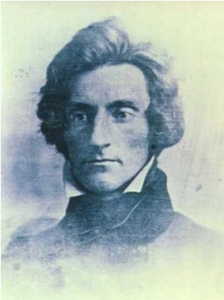Charles Ellet, Jr. was the eminent civil engineer that built the suspension bridge over the Ohio River at Wheeling in 1849. With a span of 1,010 feet, it was the longest of its kind in the world at that time. The bridge was a vital link for the more than 500 mile National Road that joined the East to the West in mid-19th century America.
Charles Ellet, Jr. was born at Penn's manor in Bucks County, Pennsylvania, on January 1, 1810. Of Quaker and Jewish heritage, the tall, lean, and handsome youth left farm life at the age of seventeen and launched a career that included building canals, laying railroads, constructing suspension bridges, submitting a flood control plan to Congress, and commanding a steam ram fleet at the battle of Memphis in 1862.
He sailed for Paris in 1830 and attended the prestigious Ecole des Ponts et Chausses. After four months of lectures he toured France and Switzerland to view bridging which he enthusiastically embraced and eventually emulated in America.
Ellet built America's first important suspension bridge at Philadelphia over the Schuylkill River in 1842. Amongst controversy and dissension he completed the first span across the Niagara River at the Falls, albeit a temporary bridge, in 1849.
When the Wheeling bridge had its formal opening that same year, 'cannons roared, bands played and the people promenaded on their bridge.' Henry Clay compared the bridge to a rainbow, as lights outlined its elegant framework in the nightime sky.
At the request of the 1850 Congress, Ellet submitted a study for securing the delta of the Mississippi River from innundation on October 31, 1851. He amplified his theories in his Report on the Overflows of the Delta of the Mississippi in 1852 and The Mississippi and Ohio Rivers in 1853. His senate document was reprinted in 1927 and 1928 and was last reprinted in 1970.
In 1862 Secretary of War Edwin M. Stanton summoned Ellet to quickly put together a fleet of battering rams in an effort to gain control of the Mississippi River at Memphis during the Civil War. Ellet had proposed naval ramming vessels for seven years prior to the Rebellion.
Stanton commissioned Charles Ellet, Jr. with the rank of colonel and he hurriedly converted nine steam ships into a likeness of his design . With his brother Alfred as second-in-command, Ellet's rams joined forces with naval Flag Officer Charles H. Davis' gunboats. The Federals were victorious in a hour's time.
Charles Ellet, Jr. suffered a mortal wound during the heat of battle at Memphis on June 6, 1862 and died fifteen days later. He laid in state at Independence Hall in Philadelphia from June 26 until his interment at Laurel Hill Cemetery on June 27.
The Suspension Bridge at Wheeling was dedicated as a National Historic Civil Engineering landmark in 1969 by the American Society of Civil Engineers. It was designated a National Historic monument in 1976 during its bicentennial. The Wheeling sesquicentennial plans will rival that of the historic bridge's opening day with events that will 'rock the town.'
- Jeannette Cabell Coley
View user comments below.
For more information:






























